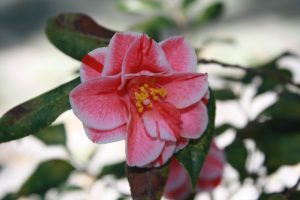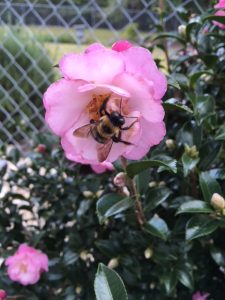 A recent visit to the Dothan Area Botanical Garden (DABG) reminded me that although many of our summer flowers are winding down, we have a great garden show coming this winter when the southern classic camellias start to show their stuff. DABG has a large collection of camellias that will start blooming in the coming months. Here is a little background on the two most common types of camellias grown in our area.
A recent visit to the Dothan Area Botanical Garden (DABG) reminded me that although many of our summer flowers are winding down, we have a great garden show coming this winter when the southern classic camellias start to show their stuff. DABG has a large collection of camellias that will start blooming in the coming months. Here is a little background on the two most common types of camellias grown in our area.
Camellia japonica
Also known as Japanese Camellia, C. japonica thrive in partial sun to full shade. Direct morning sun with some shelter from the sun in the hottest part of the day is a good compromise. Too much shade can reduce flowering, so aim for at least partial sun.
Most Japanese Camellias bloom from January to March, but some may start earlier in the season. Flower shapes include single, semi-double, anemone, peony, and formal double. Flower colors are white, pink, red, and sometimes a combination of multiple colors! Camellia japonica mature at 10-15’ tall and wide but may get as big as 25 feet. This makes them ideal to create privacy in the garden or have the lower limbs trimmed into a tree-form.
Camellia sasanqua
Sasanqua camellias also prefer part sun but can also thrive in full sun once established. Leaves and flowers are typically smaller than C. japonica which is an easy way to differentiate. Although most have upright habits and can grow 10-15’ tall as well, there are a few cultivars such as ‘Shishi Gashira’, ‘Bonanza’, and ‘Mine-no-yuki’ that have more horizontal branching making them good options for foundation plantings. Sasanqua camellia are usually in full bloom in the fall, but may bloom as late as January. Flower shapes are similar to C. japonicas, but many varieties have more open flowers with exposed stamens that are beneficial to pollinators.
- Thinking of Starting a Cut Flower Business? Don’t miss out on Cut Flower 101! - October 30, 2025
- 2025 Gardening in the Panhandle LIVE! Great Southeast Pollinator Census – Bee a Citizen Scientist! Wrap Up - September 18, 2025
- Will you Bee a Citizen Scientist? - August 15, 2025

